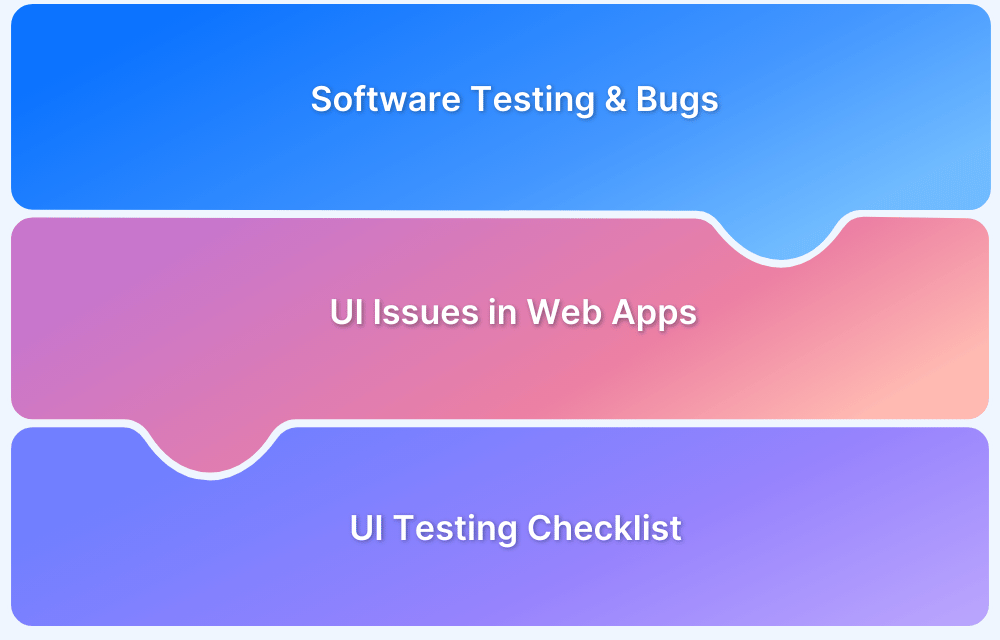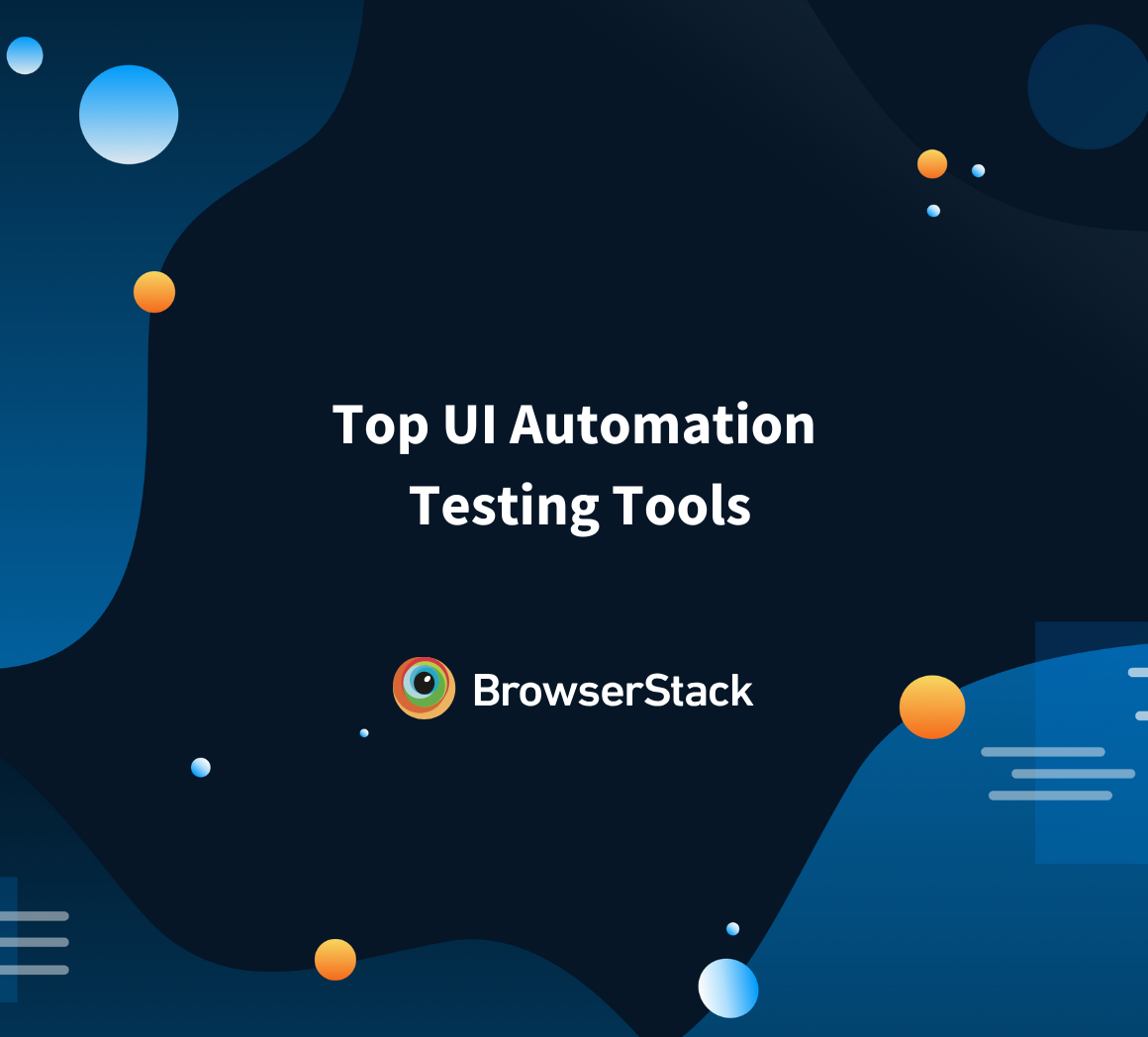A User Interface (or Graphic User Interface) is the most critical component of any mobile or web application. After all, users access the core functionalities of any application by interacting with the UI.
Overview
UI automation testing is the process of automatically testing an application’s UI using scripts and tools to verify its functionality. It ensures a seamless user experience by detecting visual and functional issues early across different devices and browsers.
Why is UI Automation Testing Important?
- Ensures Consistency: Verifies UI behavior across different browsers and devices.
- Speeds Up Testing: Automates repetitive tests, reducing execution time.
- Improves Accuracy: Minimizes human errors in test execution.
- Enhances User Experience: Detects UI glitches early for a seamless experience.
- Supports Continuous Integration: Integrates with CI/CD pipelines for faster releases.
- Increases Test Coverage: Automates complex scenarios that are difficult to test manually.
- Reduces Costs: Lowers manual testing efforts, saving time and resources in the long run.
Tools for Automated UI Testing
Here are some popular tools for automated UI testing:
Website UI Testing
- BrowserStack Percy: Visual testing tool for automated UI regression testing with pixel-by-pixel comparisons.
- Selenium: Open-source framework for cross-browser web automation.
- Cypress: Fast, JavaScript-based testing framework with real-time execution.
- Playwright: Supports multiple browsers and enables parallel testing.
- Puppeteer: Google’s Node.js library for headless Chrome/Chromium automation.
- NightwatchJS: End-to-end JavaScript framework for browser-based testing.
Mobile App UI Testing
- App Percy: Visual testing tool for mobile app UI regression testing.
- Appium: Open-source framework for automating mobile apps across platforms.
- Espresso: Google’s Android UI testing framework for fast execution.
- XCUITest: Apple’s iOS testing framework for native app automation.
Conventionally, QA teams performed UI tests manually. However, the advent of the Agile methodology has encouraged teams to adopt automation for their test cycles in order to release faster.
The emergence of Agile development models and automation frameworks has encouraged teams to replace conventional testing practices. Automated UI testing is now considered mandatory in software testing pipelines across the globe.
This article delves into the basics of automated UI testing. It also highlights the challenges of UI automation and how teams must find the right balance between manual and automated testing.
What is Automated UI Testing?
At its core, automated UI testing refers to the usage of specific tools or frameworks for automating the manual test processes that verify UI functionality. Manual tasks mentioned earlier like – validating the user navigation, UI workflows, testing logical functionality of each button, validating input fields, etc., can be automated using certain tools or frameworks.
Automating UI tests helps minimize the time and human effort required to test an application’s UI. Instead of having a tester validate every single aspect of the UI, test scripts are created for corresponding user scenarios. These test scripts can be later reused in case of code modifications or addition of new features.
At a high level, automating UI tests allows teams to:
- Simulate end-user interactions with the application’s UI
- Automate end-user inputs and test the logical functionality of each component
- Incorporate UI tests parallel to the development phase
- Generate and evaluate test results
Benefits of Automated UI Testing
Automated testing offers numerous benefits in Agile software development. Listed below are a few:
- Enables teams to increase test coverage rates significantly
- Increased test coverage fosters faster debugging
- Test scripts once created can be reused; this makes testing easily scalable
- Test execution is much faster as compared to manual testing
- Efficient test scripts deliver accurate test results
- Unlike manual tests, automated tests are not prone to human error
- Automated testing is time and cost-effective
Automation in UI testing ensures faster execution and greater accuracy by eliminating manual effort and human errors. It enhances test coverage across multiple devices and browsers, enabling seamless user experiences and efficient software releases
However, bear in mind that, although test automation has become mainstream in the agile world, manual testing carries its own importance. Refer to this detailed guide on manual testing to understand why it can’t be avoided altogether.
It is extremely important for teams to find the right balance between manual and automated testing. This is because every project is unique, and one needs to evaluate several aspects like economic feasibility, time constraints, and type of tests to be performed. Here’s where teams need to make informed decisions which can be challenging at times. This brings us to an important subject regarding the challenges in automated UI testing.
Tools used for Automated UI Testing
Here’s a list of tools that can be used for Automated UI Testing:
- Percy (Website UI Testing)
- Selenium (Website UI Testing)
- Cypress (Website UI Testing)
- Playwright (Website UI Testing)
- Puppeteer (Website UI Testing)
- NightwatchJS (Website UI Testing)
- App Percy (Mobile App UI Testing)
- Appium (Mobile App UI Testing)
- Espresso (Android Mobile App UI Testing)
- XCUITest (iOS Mobile App UI Testing)
Read More: Top 20 UI Automation Testing Tools
How to Implement UI test automation
Here is how you can implement UI test automation:
1. Define Goals and Scope
Before starting with automation, clearly define what parts of the UI need to be tested. Focus on high-priority user flows like login, search, or checkout. Decide which browsers, devices, and screen sizes matter most to your users. This helps ensure you’re automating tests that deliver the most value and avoid wasting time on rarely used features.
2. Choose the Right Tools and Frameworks
Select an automation tool that aligns with your application’s tech stack and your team’s skillset. For web apps, frameworks like Cypress, Selenium, Playwright, or TestCafe are common, each offering different benefits in terms of speed, syntax, and reliability. For mobile apps, you can use Appium, Espresso, or XCUITest.
If cross-browser or cross-device testing is essential, consider using cloud platforms like BrowserStack, which allow you to run your tests on a wide range of real devices and browsers without maintaining the infrastructure yourself.
3. Set Up the Test Framework
Establish a structured test environment using a reliable test runner and organizing your test files in a scalable way. Implement design patterns like the Page Object Model to improve maintainability and reduce duplication.
Include assertions that check for expected UI behavior and set up hooks to manage pre-test setup or post-test cleanup. A solid framework foundation makes writing and maintaining tests much easier as your app grows.
4. Create Reliable Locators
Use stable selectors for identifying UI elements in your tests. Avoid brittle locators like complex CSS paths or those dependent on text that might change.
Prefer unique IDs or custom `data-*` attributes designed for automation. Stable locators reduce test flakiness and help ensure your tests remain valid even as the UI evolves.
5. Handle Test Data and State
Ensure your tests have access to consistent and predictable data. Use fixtures or mock APIs to simulate user inputs and backend responses. Reset application state before or after each test to avoid data pollution. Isolated, state-independent tests are more reliable and easier to debug when they fail.
6. Run Tests in CI/CD
Integrate your test suite into your CI/CD pipeline to automatically run tests on each code change or pull request. Use tools like GitHub Actions, Jenkins, or GitLab CI to orchestrate test runs and generate results. This helps catch regressions early, maintain code quality, and ensure the app works correctly across environments.
7. Review and Maintain
Regularly update your tests to reflect UI changes and remove outdated or redundant tests. Monitor for flaky tests and address the root causes rather than ignoring or disabling them. Well-maintained test suites give you confidence in the application’s stability and reduce time spent debugging false positives.
8. Follow Best Practices
Stick to best practices like starting small with smoke tests, running tests in headless mode for faster execution, and capturing screenshots or logs for failed runs. Not every scenario needs automation. Prioritize high-value and high-risk areas. Good practices lead to a more stable and scalable test automation strategy.
Challenges in UI automation testing
Every QA team faces certain challenges during test automation. Needless to say, these challenges can adversely affect the test process and may hinder the overall project delivery timelines.
Listed below are some of the common challenges faced by teams during test automation.
1. Identifying the right automation tool for extensive testing
There are numerous tools available on the internet (both paid and open-source). Every tool is designed uniquely to address specific issues. Needless to say, each tool has its compatibility criteria and requires QAs to have expertise in a particular language. Given this, it becomes very difficult to evaluate the ideal tool that meets all business and technical requirements.
2. Diversity in the test environment
The web is highly fragmented and the diversity in the combination of devices and operating systems used to access an application continues to increase. Testing and optimizing UI for all platforms in such a fragmented environment is extremely difficult. Comprehensive testing requires an extensive test infrastructure. This means teams need to set up on-premise device labs that demand huge investments. This drives us to the next challenge.
Read More: How to ensure Maximum Test Coverage?
3. Test automation demands enormous investment
Making enormous investments to set up on-premise device labs may not be feasible for small or medium-scale organizations. Although the expenses incurred to set up the required test infrastructure pays off in the long term, the cost of incorporating automation in the early stages is considerably high.
4. Automation requires technical expertise
Test automation is a technically complex task and requires individuals to be proficient with specific programming languages and frameworks. Without the required skill sets, teams won’t achieve the desired level of test automation.
Read More: Introduction to Android UI Test Automation
Best Practices for UI Automation Testing
Here are the best practices to follow while performing UI automation testing:
- Automate Critical and Stable Flows Only: Focus on high-value user journeys like login, checkout, or search. Avoid automating unstable or frequently changing areas to reduce maintenance overhead.
- Use Reliable Locators: Always use stable selectors like unique IDs or data-testid attributes. This makes your tests less prone to breaking with UI changes.
- Keep Tests Independent and Fast: Ensure tests don’t rely on each other and avoid long execution times. Independent, atomic tests are easier to debug and run in parallel.
- Integrate with CI/CD: Run your UI tests automatically on every code push using tools like GitHub Actions or Jenkins. This helps catch regressions early.
- Maintain and Monitor Regularly: Regularly review tests for flakiness, update broken locators, and remove outdated scenarios. A healthy suite builds long-term trust.
Using BrowserStack to Address the Challenges
An ideal solution for teams to address the above challenges is to opt for a cloud-based testing platform like BrowserStack for automated UI testing. Its Cloud Selenium Grid allows developers and QAs to run concurrent Selenium tests on real mobile and desktop browsers. With the recent addition of Cypress on BrowserStack’s cloud, teams can also run automated Cypress tests for their application’s interface across browsers.
Try Automated UI Testing for Free
Additionally, one can also leverage its real device cloud (consisting of 3500+ real devices and browsers) to run automated UI tests for mobile apps on real Android and iOS devices. To do so, one can easily integrate with app automation frameworks like Appium, XCUITest, Espresso, etc. Testing on real devices allows QAs to test the UI of an application in real user conditions.
As the infrastructure is completely cloud-based, developers or QAs do not need to worry about the purchase or maintenance of any on-premise device labs. They simply need to sign up for free, choose the required devices and get started with testing.
Although configuring and setting up automated UI tests may be time and effort-intensive in the initial phase, it proves to be cost-effective in the long run. Additionally, it empowers teams to speed up their test cycles to achieve maximum test coverage and release faster – thus maintaining a competitive advantage in a dog-eat-dog digital market.
Conclusion
Automated UI testing ensures a seamless and consistent user experience across various devices and browsers. It enhances efficiency, reduces manual effort, and improves test accuracy, making it an essential part of modern software development. However, challenges like tool selection, diverse test environments, high investment costs, and technical expertise requirements can impact automation efforts.
By leveraging BrowserStack, teams can overcome these challenges with real device testing, scalable cloud infrastructure, and seamless integration with popular automation frameworks, ensuring faster, more reliable, and cost-effective UI testing.







